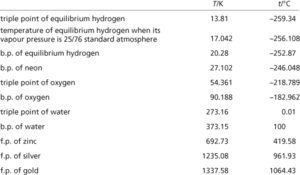A number of empirical scales of temperature have been in use: the Celsius scale is widely used for many purposes and in certain countries the Fahrenheit scale is still used. These scales both rely on the use of fixed points, such as the freezing point and the boiling point of water, and the division of the fundamental interval between these two points into units of temperature (100 degrees in the case of the Celsius scale and 180 degrees in the Fahrenheit scale).
However, for scientific purposes the scale in use is the International Practical Temperature Scale (IPTS), which is designed to conform as closely as possible to thermodynamic temperature and is expressed in the unit of thermodynamic temperature, the kelvin. The 1968 version of the table (known as IPTS-68) had 11 fixed points defined by both Celsius and thermodynamic temperatures. The most recent version (IPTS-90), introduced in 1990, has 16 fixed points with temperatures expressed in kelvins:
• Triple point of hydrogen: 13.8033
• Boiling point of hydrogen (33 321.3 Pa): 17.035
• Boiling point of hydrogen (101 292 Pa): 20.27
• Triple point of neon: 24.5561
• Triple point of oxygen: 54.3584
• Triple point of argon: 83.8058
• Triple point of mercury: 234.3156
• Triple point of water: 273.16 (0.01°C)
• Melting point of gallium: 302.9146
• Freezing point of indium: 429.7485
• Freezing point of tin: 505.078
• Freezing point of zinc: 692.677
• Freezing point of aluminium: 933.473
• Freezing point of silver: 1234.93
• Freezing point of gold: 1337.33
• Freezing point of copper: 1357.77
Methods for measuring intermediate temperatures between these fixed points are specified; for example, at low temperatures (0–5 K) they are measured by means of vapour-pressure determinations of 3He and 4He; at high temperatures (above 1234.93 K) a radiation pyrometer is used.
A number of empirical scales of temperature have been in use: the Celsius scale is widely used for many purposes and in certain countries the Fahrenheit scale is still used. These scales both rely on the use of fixed points, such as the freezing point and the boiling point of water, and the division of the fundamental interval between these two points into units of temperature (100 degrees in the case of the Celsius scale and 180 degrees in the Fahrenheit scale).
However, for scientific purposes the scale in use is the International Practical Temperature Scale (1990), which is designed to conform as closely as possible to thermodynamic temperature and is expressed in the unit of thermodynamic temperature, the kelvin. The eleven fixed points of the scale are given in the table, with the instruments specified for interpolating between them. Above the freezing point of gold, a radiation pyrometer is used, based on Planck’s law of radiation. The scale was extended in 2000.

Temperature scales
An empirical scale used to represent the physical property of temperature of a body. There are a number of scales in use and each is calibrated with fixed points to represent zero degrees, such as the freezing point of water and another temperature, such as the boiling point of water at standard atmospheric pressure, with a division between them to permit interpolation. In the case of the Celsius this is 100 degrees. For scientific purposes, the kelvin scale is used, which has absolute zero as a fixed point and other fixed points with divisions used to interpolate between them. They commonly are related as:
Fahrenheit to Celsius:
Celsius to Fahrenheit:
Celcius to kelvin:
- sense of place
- sense organ
- senses
- sensibilia
- sensibility
- sensible heat
- sensible knave
- sensible world
- sensillum
- sensing element
- Sensitive High Resolution Ion MicroProbe
- sensitive period
- sensitive sectors
- sensitive tint
- sensitivity
- sensitivity analysis
- sensitization
- sensor
- sensor-data fusion
- sensorium
- sensor network
- sensory cell
- sensory neuron
- sensus communis
- sentence